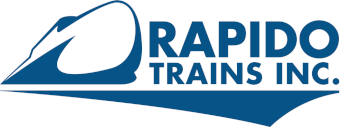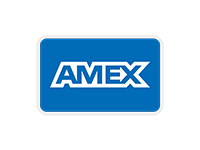By Dan Dell'unto
GO Transit
In the mid-1980’s Toronto area commuter operator GO Transit, looking to standardize and modernize its mixed-bag fleet of "40-series" EMD power with newer more modern commuter power, worked in collaboration with EMD to improve upon their existing passenger locomotive design in a number of ways, ultimately creating the new F59PH model. Over the next few years, they would purchase four separate orders of F59’s, built at the GMD London plant between 1988 to 1994. Standardizing on this model for all their operations, GO become the owner of the largest fleet, with 49 units at its peak (520-568). This resulted in the retirement and disposal of all of GO's old commuter power, including their GP40TC, F40PH, GP40-2W and GP40-3 models, as well as the control cab APCU and APU (former F-units) used for Head End Power.
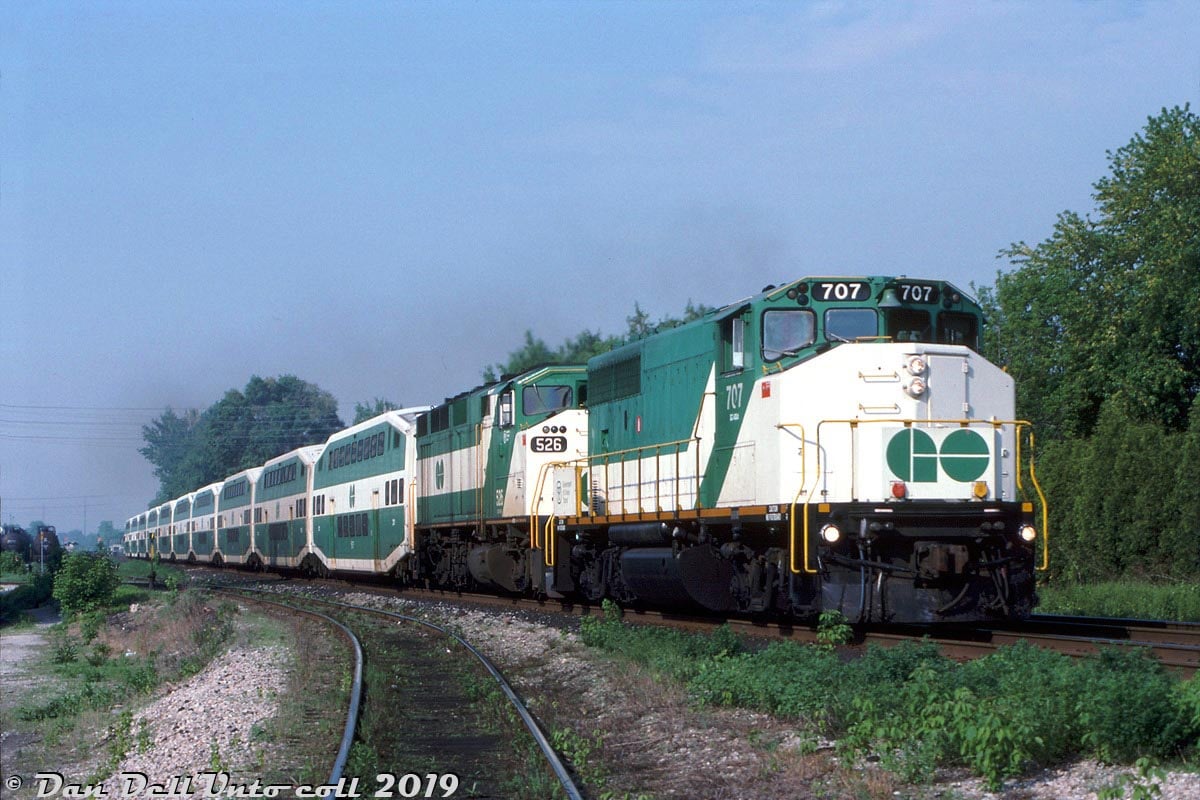
GO 707 leading 526 at Mississauga, Ontario in May, 1991. Photo by Peter Jobe, courtesy of Dan Dell'Unto.
During the early years, it wasn’t common to see F59PH’s operating with older GO power on the same train consist, but it did happen. Sometimes, new units would be leased or lent out for demonstration purposes, or to cover equipment shortages. In the early 90’s, GO F59PH and bilevel consists were lent out to VIA for corridor service to cover equipment shortages associated with wheel problems on their LRC cars. A few newly minted units including 552 (in California) and 561 (in Maryland) travelled to the United States to demonstrate in the early 90's, in an effort to promote heavy commuter rail. This contributed to the start-up of operator Metrolink in California. Also, none of GO’s F59PH units were leased out to CN or CP for freight service like prior GO power was in earlier years.
From thereon, the F59PH was the face of GO Transit and Toronto commuter trains for nearly two decades, being their sole power after disposing of the last of their GP40’s in 1994. A mild hiccup came in the mid-90’s when funding cuts and service reductions resulted in a few units being put up for sale in 1996, and four of the newest units (565-568) being sold to Texas commuter start-up Trinity Railway Express, reducing GO’s fleet to 45 units.
Aside from the four units sold, the rest of the fleet remained and eventually received overhauls in the late 90's/early 2000's for continued in service as GO’s primary commuter power. Starting in late 2001, rooftop mounted RV-style air conditioners started appearing on some of the rebuilt units, and it would take about two years for the rest of the fleet to get them. This necessitated removal of the air vent on the cab rooftop on units so equipped. In 1999 one unit, 527, received the new "swoosh" logos that were being applied to buses at the time. It briefly sported the new logos for a few months before being reverted back to the standard GO logo (apparently it was difficult to read at speed).
The F59PH continued to maintain the status quo until the late 2000’s, when the first of GO’s new MotivePower Industries MP40PH-3C locomotives entered service in February 2008. Through the delivery and introduction of the first batch of MP40’s (600-626) in 2008 to early 2009, they operated with and alongside the F59PH fleet, although many older F59’s were often parked or stored out of service. It was common to see a new MP40 being broken in with an F59PH trailing. Once broken in, one of the first assignments MP40’s took over from F59’s were some runs on the Milton line. Due to constraints by line owner CP on adding more Milton trains, GO elected to increase capacity by expanding consists from 10- to 12-car trains and expanding platform lengths. The F59’s HEP capacity was limited to a maximum of 10 cars, thus the new MP40’s were used on those 12-car Milton line runs. Platforms at other stations were also expanded to operate those 12-car trains on other lines, limiting the F59’s usefulness to runs operating 10-car and shorter consists.
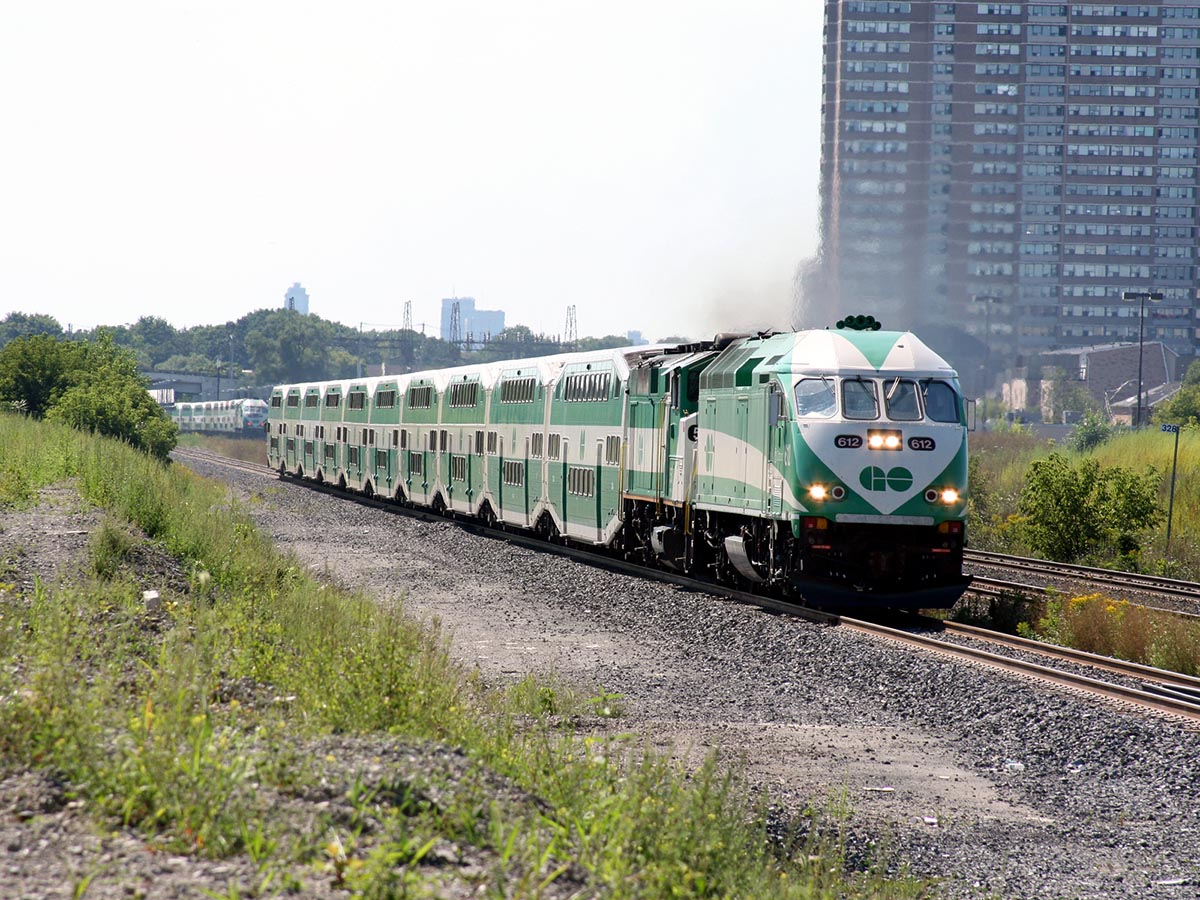
Brand new GO 612 runs with 557 eastbound out of Toronto, Ontario in August, 2008. Photo by Dan Garcia.
By early 2009, the first order of new MP40 units had all been delivered, and the first batch of F59PH’s (520-535) were retired and sold off. Most of them went Rosen Beaudin Railway Leasing Inc (aka RB Leasing, owned by and named after the former owners of CAD Railway Industries) to lease out and/or resell to other commuter operators. Commuter operators Trinity Railway Express and Rail World (to lease to AMT) also picked up three units each.
The second order of MP40’s delivered in 2010 would cull more of the F59PH herd, with 11 more units being sold to RB Leasing in March and July 2010. A third order of MP40’s delivered in 2010-2011 rendered more of GO’s remaining F59 fleet surplus, and ten units were sold to Montreal commuter operator AMT.
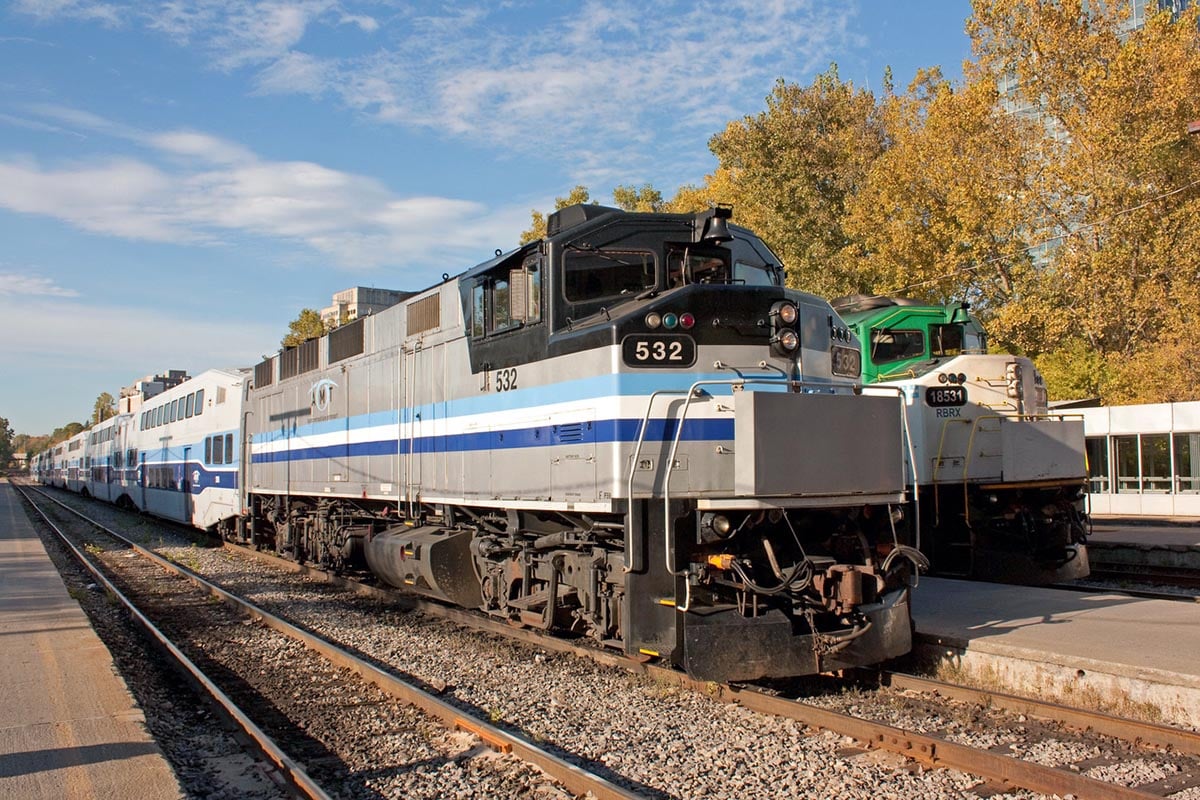
Railworld sits with its train in Montréal, Québec in October, 2012. Photo by Thomas Blampied.
Rather than sell their few of their remaining F59PH units around, GO decided to keep and overhaul 8 of their youngest remaining units in 2011 for continued service. The main external visual changes to the units (557-564) were the addition of a new e-bell and a white frame stripe during repainting (instead of yellow). A year or two after their overhauls, their horns were relocated from ahead of the dynamic brake fan to the front of the cab, above the bell. They remain in service on GO today, usually on shorter consists that run on some corridors in off-peak and rush-hour service. For a time, they were utilized on “L10L” consists, with a unit on each end of the train to combat wheelslip issues with fall leaves on the tracks on the Barrie line. None to date have been repainted in the new Metrolinx livery.
PASSENGER EQUIPMENT:
GO Transit’s F59PH fleet operated for most of their lives with the iconic bilevel commuter cars, that also made their debut on GO Transit. Most of GO’s old single-level Hawker Siddeley commuter cars were sold off around the time GO was phasing out its older power, resulting in the F59PH units operating primarily with bilevels. Shorter consists were common in earlier years, but by the 2000’s typically F59PH’s operated solo with anywhere from 6 to 10 car consists, depending on the equipment allocation for each run on a line. An off-peak consist could operate with a single F59PH and just six cars (an accessible car was always to be in the “5A” position due to station platform accessibility ramps). Peak trains on busy lines often had 9- and 10-car consists. In the mid-2000’s, it also wasn’t uncommon to see 10-car consists with double-heading F59PH’s (an “LL10” consist) on certain weekend and weekday Lakeshore line consists for better acceleration. Doubleheading units were almost always oriented “elephant style” (both facing the same direction), with the rare exception in later years when some briefly ran back-to-back.
Metrolink
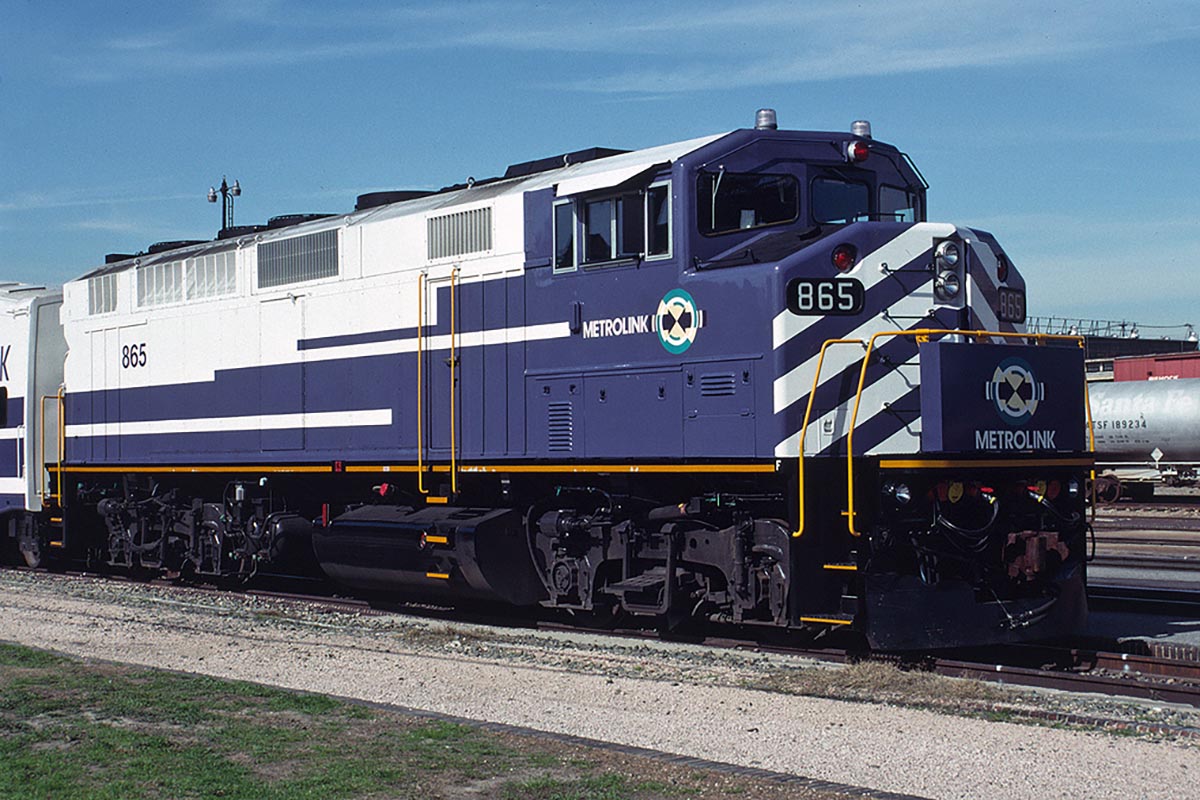
Metrolink 865 sits with its train in San Bernadino, California in January, 1993. Photo by Craig Walker.
Startup commuter operator Metrolink (the Southern California Regional Rail Authority, reporting marks SCAX) was the only other original purchaser of the F59PH model. They initially ordered 19 units from EMD in 1992 (851-869) in preparation commencing operations on three commuter lines in October of that year. Four more F59PH's were ordered in 1993 (870-873). As they expanded service and inaugurated more commuter lines throughout the 90's, Metrolink placed multiple orders for the successor F59PHI model.
Metrolink's F59PH units are Phase 2 carbody versions, with red nose markers and a single red marker light mounted above the cab windows. As-delivered they were painted in the original purple-blue and white livery, that featured a blue front end and cab with prominent nose striping. Later, a simplified all white livery with blue side stripes and logos was adopted. More recently, some units have been repainted into the green ribbon paint scheme, although a few sport “ghost livery” versions without the ribbons.
Due to California emissions regulations, starting in the early 2010’s Metrolink had MotivePower Industries upgrade seven F59PH units to meet EPA Tier 2 engine emissions, which included an upgraded cooling system with a more prominent radiator section.
In 2016, Metrolink took delivery of the first of their new EMD F125 locomotives that meet EPA Tier 4 emissions standards. Deliveries in the late 2010's retired all of the unrebuilt F59PH units, and it is expected that the rebuilt Tier 2 F59PH units and all of the F59PHI's will be retired by the time the full order of F125's is delivered. Part of the funding agreement for the new Tier 4 F125's is that the older F59PH's must be rendered inoperable when retired. Five of the retired F59PH units have been sold to NC Dot for rebuilding and repowering, and have had their diesel engines removed to meet the resale conditions for the F125 funding.
During PTC installation on their own units, in late 2013 Metrolink leased three ex-GO Transit F59PH's from RB Leasing to cover for units undergoing overhaul. The units leased were RBRX 18520, 18522, (both still in ex-GO colours) and 18533 (painted in MiTrain colours). They later changed ownership to Larry's Truck & Electric during the lease.
NC Dot
NC Dot got on the F59PH bandwagon in 2009 when they picked up two ex-GO F59's from RB Leasing, followed by another soon after, and one more in 2011. All units were overhauled and repainted into their blue and silver livery with "North Carolina" markings. In 2013 they picked up seven more ex-GO F59PH's from RB Leasing, and transported them south where two were overhauled at NS's Altoona Shops and kept as powered units. The five others were rebuilt by Altoona as non-powered cab control units (CCU) numbered 101-105. At last check they were waiting for FRA approval before entering service.
Unlike other railways and transit agencies who number their units sequentially, the NC Dot units are numbered after significant years in North Carolina's history. Each also features a name of a different city in North Carolina.
NC Dot has also picked up five retired F59PH's from Metrolink in late 2018, after they had been replaced by new F125's. They were acquired as shells with no prime movers. Three are intended to be rebuilt as EPA Tier 4 emissions units with new engines (prior rebuilds were done to EPA Tier 0+ standards), and two are to be kept for alternative fuels research and development testing (possibly as battery and fuel cell test units).
In October 2016, RNCX 1859 had a Blended After-Treatment System (BATS) installed, designed to to further decrease emissions from Tier 0+ to Tier 3+ levels. The main external spotting features are a different and taller dynamic brake hatch to accommodate the Selective Catalytic Reduction (SCR) equipment, additional rooftop duct work, and an underframe mounted Diesel Exhaust Fluid (DEF) tank.
When rebuilt, the units had their numberboards and red marker lights relocated from the nose to the cab roof, the bell relocated, different air conditioner units, and new plows added.
Metra
Previously a big purchaser of EMD's F40PH model (including a later group with sloped front cab named "Winnebagos"), due to a funding crunch Metra had been on the hunt for secondhand power to augment its fleet. Having acquired and rebuilt three secondhand F40's in prior years, their first F59 purchase was the three Rail World units that had previously been on lease with AMT (ex-GO 526, 530 and 532). They were rebuilt at NS's Juniata Shops in 2015, and repainted at Metra's Kensington Yard shops in a newly debuted blue, silver, red and black livery.
In 2018 Metra acquired more secondhand F59's in the form of 21 F59PHI's from Amtrak California, and three more ex-GO F59PH's from Larry's Truck & Electric (who had purchased some of RB Leasing's units). These ones were former 18523, 24, 31 which had also been leased to AMT, and were rebuilt and emerged as Metra 94-96 in mid-late 2019.
Notable changes to the Metra F59PH's include replacing the GO class lights with single red marker lights in separate housings, and adding a gyralight mounted above the front the cab windows where the bell once was, and a dual-sealed beam rear headlight replacing the single headlight. All are Phase 1 body units.
Trinity Railway Express
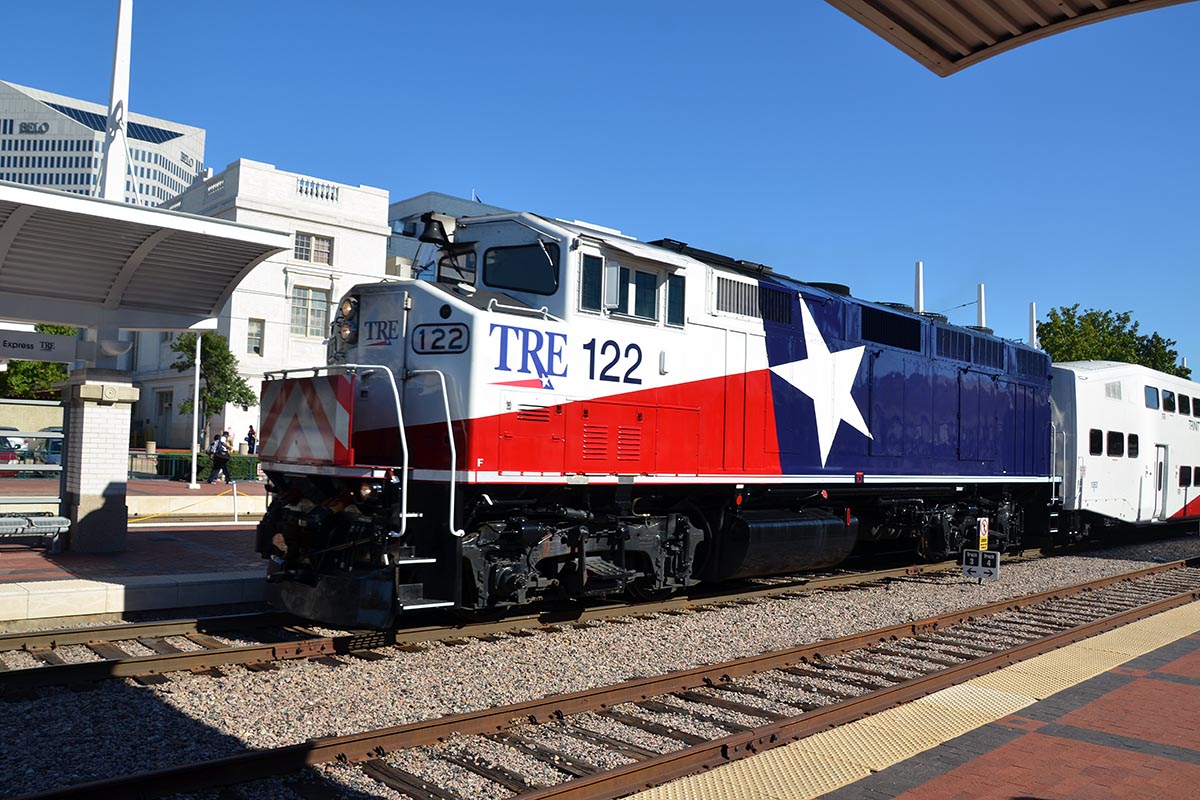
TRE 122 (ex GO 528) sits at Union Station, Dallas, Texas. Photo by Craig Walker.
Startup Dallas–Fort Worth TX commuter operator Trinity Railway Express initially picked up four of GO Transit's nearly new F59PH's from their last order, that had been in service on GO for barely 3 years at that time. GO had stored some of its F59PH units in late 1996 due to service reductions, and put some up for sale. TRE purchased units 565-568 along with a group of 14 older 2000-series GO bilevel cars in 1997. They were repainted and entered service, and a pair of F59PHI units bought new from EMD supplemented the fleet in 2001 (569-570).
Years later, when GO began disposing of its F59PH's, TRE was one of the first in line and picked up 3 units in early 2009 (525, 527 and 528). They were rebuilt at NS's Juniata Shops and renumbered 120-122. TRE 565-568 were also rebuilt around that time, and renumbered above the older units as 123-126. They all received a simplified "Lone Star" paint livery eliminating the shadow behind the star, and feature single (red) class lights on the nose, and elimination of the RV-style air conditioners on the roof of the newly acquired units. Units 525, 527 & 528 are Phase 1 body units, and 565-568 are late Phase 2 (or Phase 3) body units.
VIA Rail Canada (RB Leasing/RBRX)
VIA leased a trio of ex-GO Transit F59PH's from RB Leasing for its Montreal – Jonquière and Montreal–Senneterre trains, units 18520-18522. Like the rest of the RBRX fleet, they retained their former GO colours with basic RBRX lettering added (and had Canadian flags added to replace the Ontario provincial flags on the nose). Notable is how VIA used the F59's on this run: departing Montreal, the two trains ran combined as a single train 601/603 to Hervey Junction, where they were split up into two trains and continued on to their respective destinations. Consists of this train sometimes looked comical and overpowered, as 3 F59's might be leading only 4-5 cars (including two baggage cars). This was because each train needed their own unit, and the turntable at Jonquière was out of service, thus necessitating running a pair of units back-to-back on 601 to run around the train for the return trip. It doesn't appear the F59’s were used on any other trains by VIA.
When these three units came off lease with VIA, they were then leased to AMT for Montreal area commuter service (and the Canadian flags were then replaced with Quebec provincial flags). All are Phase 1 body units.
AMT/EXO (RB Leasing, Rail World, and AMXX purchased units)
Not long after GO sold off its initial group of F59PH units, AMT leased some of them for their Montreal-area commuter operations. At that time AMT's own fleet was getting up in the years, and they had been leasing a hodge-podge of old American power to help fill equipment needs (including former Amtrak F40PH's, NJ Transit F40PH's, GP40FH-2 "Warthogs", and NJ transit Comet commuter cars). AMT didn't have any F59PH's of their own, but they did have 11 of the later-model F59PHI units on the roster delivered in 2000 and 2001.
Initially, AMT leased their F59PH's from two different companies: Rail World Inc (owner of Montreal, Maine & Atlantic Ry) acquired three ex-GO F59PH's in 2009 and rebuilt them at their Derby Maine shops for lease to AMT. They emerged as "SLC" 526, 530 & 532 (the small SLC letters were later removed by AMT) and were repainted in an Amtrak-esque silver and black livery featuring AMT's blues in place of Amtrak's red and blue stripes, similar to the dozen or so former Amtrak F40PH's AMT had on lease at the time. When the three Rail World F59PH's went off lease from AMT, they were sold to Metra in 2015 (becoming Metra 97-99).
AMT also leased a handful of units from RB Leasing. Initially RBRX units 18523, 18524, 18531 were on lease, and retained their GO liveries (with Quebec provincial flags in place of Ontario ones on the nose sides). The three were eventually repainted into a spartan AMT silver livery with logos. Unit 18533 later joined them in its unique MDOT "MiTrain" paint. It had been done up and shipped to Michigan for the Michigan Department Of Transportation's start-up "MiTrain" commuter operation that never materialized. The units operated in service with AMT commuter equipment including older and newer Bombardier Bilevels and Multi-Levels, and the single-level Hawker Siddeley cars acquired from GO Transit decades earlier.
Additional leased F59PH units joined AMT later: RBRX 18520-18522 when they went off lease from VIA in 2012, and at least two units from the second group RB Leasing acquired in late 2013 (RBRX 18547 & 18551).
Finally, after leasing F59PH units from Rail World and RB Leasing for a number of years, AMT stepped up to the plate and purchased 10 units of their own from GO's final lot of retired F59PH's in August 2011 (units 543-545, 548-550, 552, 553, 555 and 556). The units sat at Mimico for nearly a year before being relettered as AMXX 1340-1349 and shipped east to their new owner.
Initially AMT put at least two units into service retaining in their old GO livery (1341 & 1342), but it wasn't long before four were in service and all had been repainted by AMT into their spartan livery with logos (1342, 1344 and 1345 were done in silver, 1341 was done in white). Some of them operated with and alongside AMT's leased F59's until those came off lease and were returned.
The six other units AMT purchased that didn't enter service were sent south to Brookville Locomotive in PA for overhauls and repainting in 2013, and returned in AMT's two-tone blue and silver livery. The four units that were in service would later follow.
Notable F59PH modifications made for AMT were single class lights on the noses (red), e-bells, and dual Nathan K5 horns at the front for redundancy. All are Phase 2 body units. Following a change in branding in 2017, some units began getting new white Exo lettering ("exo" in all lowercase) on a black front display panel. The side AMT logos were painted out in matching blue.
DETAIL VARIATIONS
The balance of F59PH production had two different body styles. For the purposes of identification, they’ll be known as “Phase 1” and “Phase 2”:
Phase 1: GO 520-535
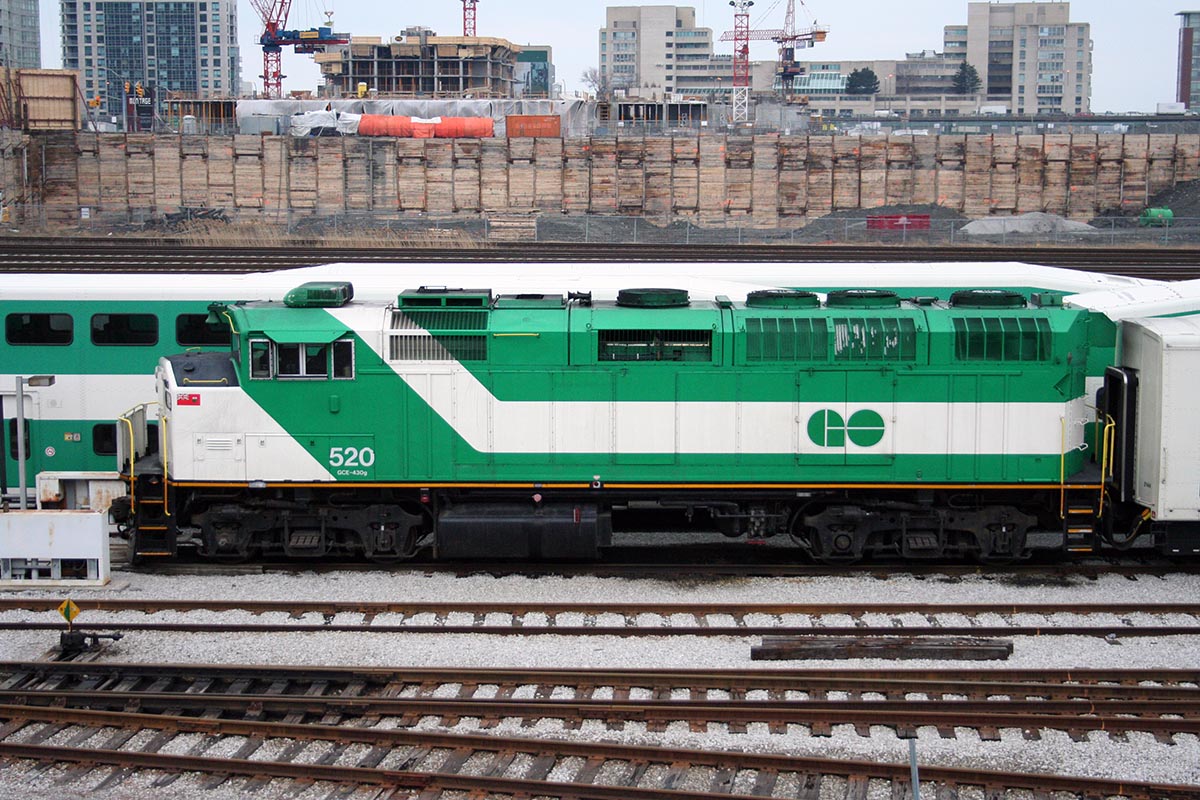
GO 520 sits and waits for its next piece of work in Toronto, Ontario in March, 2006. Photo by Brendan Frisina.
- Equipped with 1500 gallon fuel tanks
- Earlier HEP grills (large HEP grill area on either side)
- Delivered with rear MU cable pockets on rear pilot, later units had two grab irons
- Delivered without rear HEP intake vent housing (added at a later date)
- Delivered with horn mounted offset on conductor’s side, on angled portion of hood (relocated later).
- Delivered with white body stripe painted higher up on sides (didn’t match bilevel stripe, corrected when units repainted).
- Delivered with support bracket under front of anticlimber (added to 546 too).
**GO 533 received later style HEP grill setup (Phase 2) sometime in 2000’s
Phase 2 early: GO 536-560
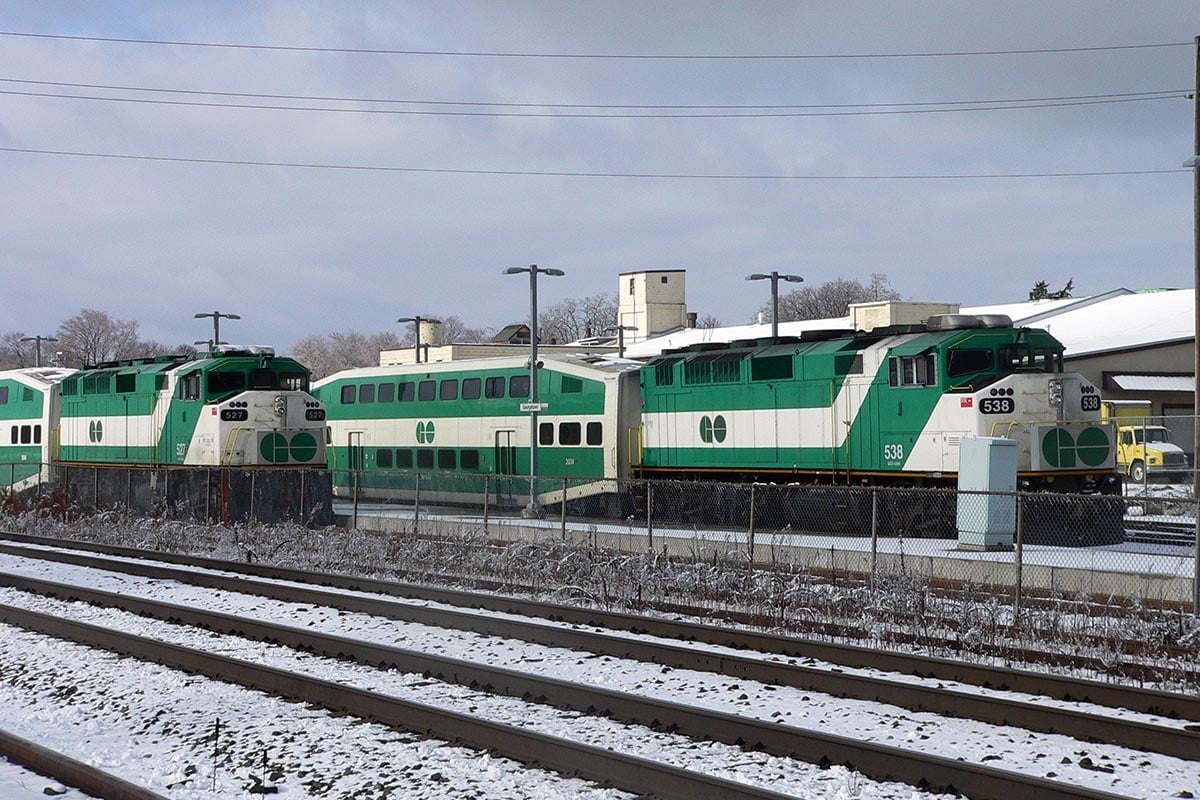
GO 527 and 538 sit in Geogetown, Ontario in January, 2006. Photo by Stephen Gardiner.
- Equipped with larger 1850 gallon fuel tanks
- Additional drip rail on cab sides above battery box covers.
- Additional side carbody rib on both sides behind cab.
- Later HEP grills (2/3rds size HEP grill area, with small access hatch on side and small square grill added above)
Phase 2 late (or Phase 3): GO 562-568, Metrolink 851-873 (*same as Phase 2, but...)
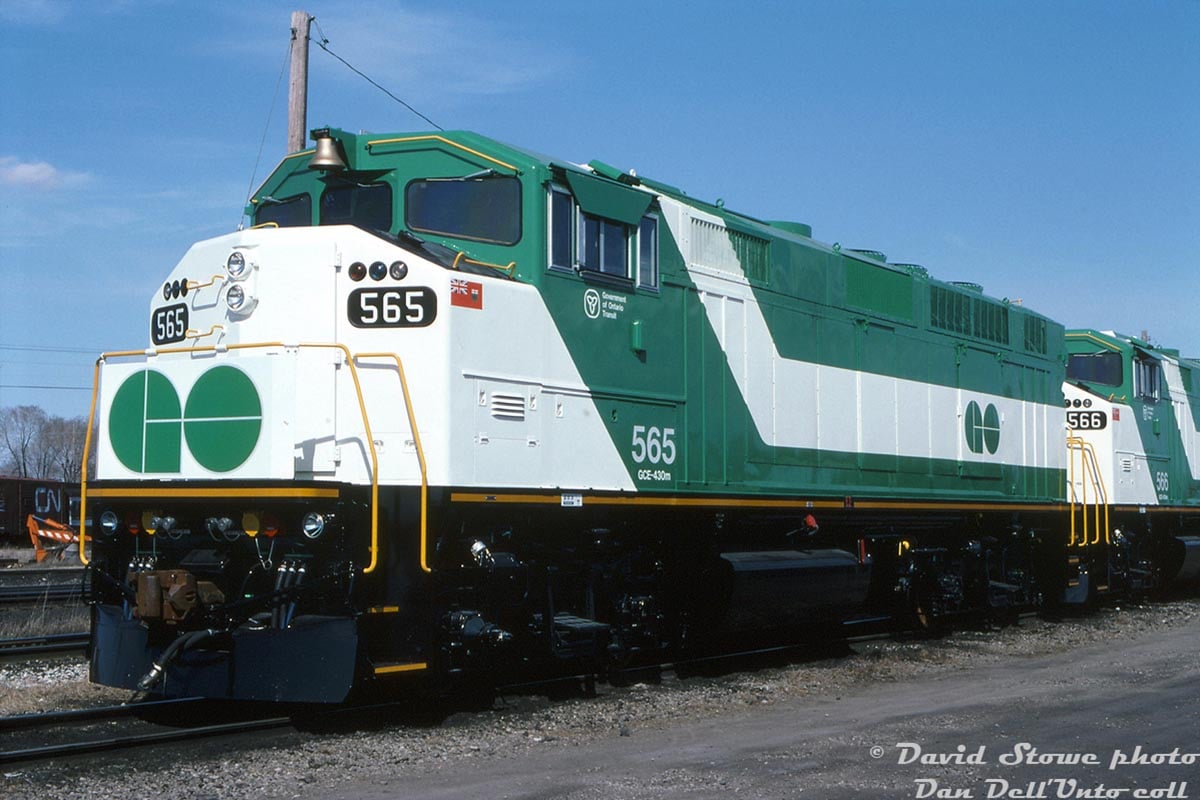
GO 565 and 566 sit in London, Ontario after being released from the EMD plant. Photo by David Stowe, courtesy of Dan Dell'Unto.
- Different front and rear HEP plug arrangement, different anticlimber supports.
- Rear class lights placed on built-out mounts.
- Top roof cab vent mounted offset over conductor’s side of cab.
GO unit detail changes over the years
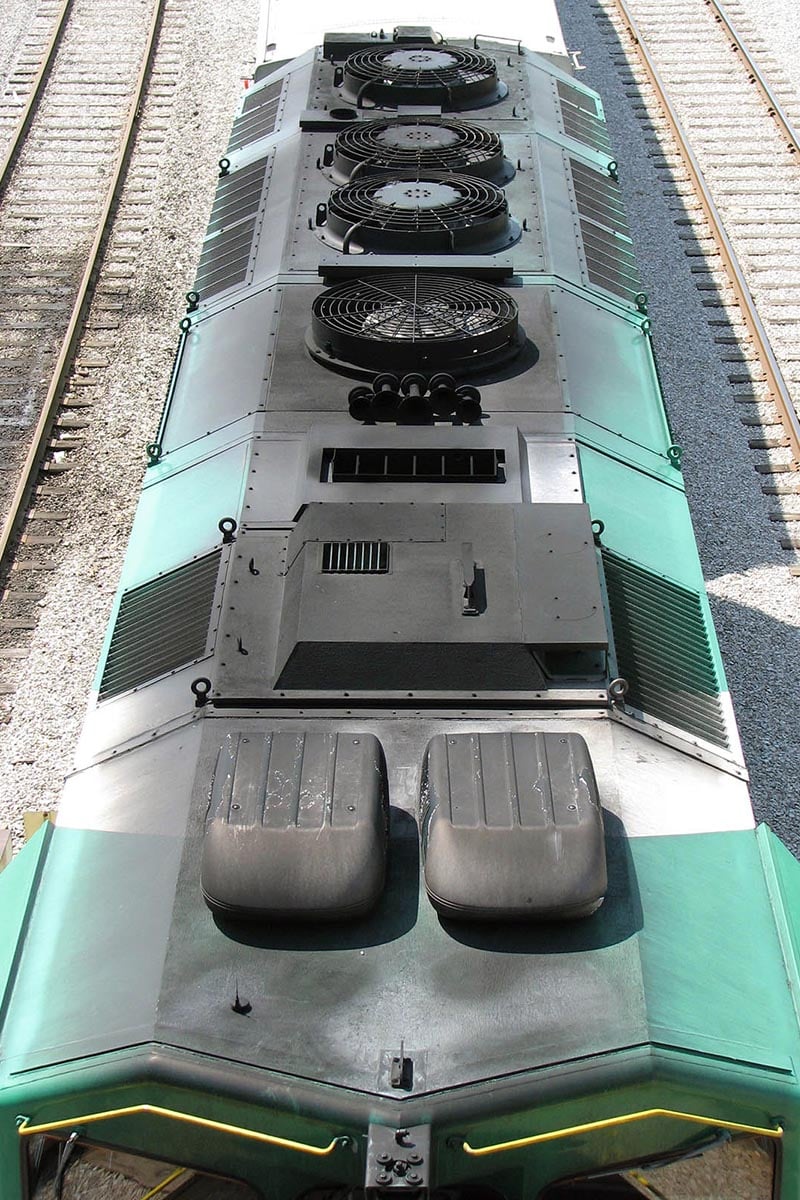
Rooftop details of GO 557 as sits west of Union Station, Toronto, Ontario. Photo by Dan Dell'Unto.
- Horns on early units (520-535) relocated from side of roof to top of roof in front of dynamic brake fan. Retained small grab by old horn location.
- All units except 529 lost their GMD-style numberboards in favour of a smaller rounder CN style (520-535) or a larger bolder round font (536-564, and later 530).
- All units wore standard GO Transit livery, with unit 527 temporarily receiving newer style GO “swoosh” logos in 1999.
- Dual RV-style cab air conditioners mounted on the roof of units starting in 2001 and over the next few years, replacing top cab rooftop vent.
- Rear class lights plated over on some units after rebuild.
- Antenna relocated to roof of inertial hatch in mid-2000’s, small antenna plane added to left side.
- When overhauled in 2011, remaining eight units received e-Bells. Horns were relocated to cab roof above bell a year or two after overhaul.
